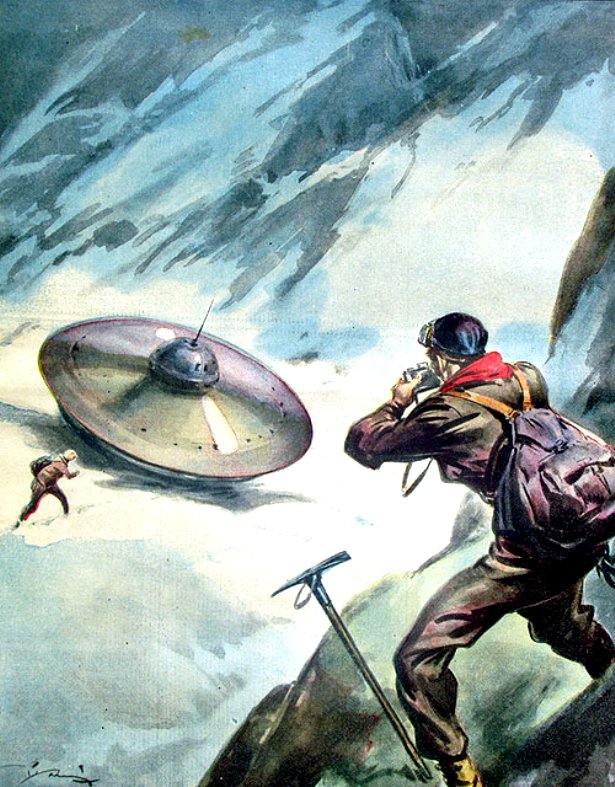by Charles Lear
 In the hunt for proof that strange vehicles are flying through our atmosphere, possibly under the guidance of alien pilots, researchers have long looked to photographs. There are some, such as the McMinnville photos, that have become classics that continue to spark debate. Many have been passed through time by newspaper articles, books, magazines, documentaries, and websites. Of course, along with the photo, there is the story of the photographer, though getting that story straight might prove difficult.
In the hunt for proof that strange vehicles are flying through our atmosphere, possibly under the guidance of alien pilots, researchers have long looked to photographs. There are some, such as the McMinnville photos, that have become classics that continue to spark debate. Many have been passed through time by newspaper articles, books, magazines, documentaries, and websites. Of course, along with the photo, there is the story of the photographer, though getting that story straight might prove difficult.
In October of 1952, a story went across the newswires that a man in Italy had claimed to have taken pictures of a flying saucer and its occupant while climbing in the Bernina section of the Italian Alps. He told reporters that he saw a flying saucer land on a glacier. According to him, “a human shape wearing some sort of diving suit” got out, walked around the ship, and then got back in. The saucer rose up and “it took off without a sound at breathtaking speed.” He said he sold the photos to a French magazine.
The man was 29-year-old Italian engineer Gianpietro Monguzzi. His story is told in detail and his pictures are presented in the Sept.-Oct. 1958 issue of Flying Saucer Review. According to the article “Monguzzi Takes Saucer Photos of the Century,” written by Lou Zinstag, Monguzzi (first name given as Giampiero by Zinstag) worked as an engineer in Monza, near Milan, and was a member of the Edison Society of Italy. On July 31, 1952, he was hiking in the Bernina Mountains with his wife when they came across an object, shaped like a flying saucer, sitting on a glacier. Moguzzi wanted to get closer, but his wife was frightened and insisted he stay with her. He did so and took a series of pictures showing the saucer on the ground, a humanoid walking around it, and two “excellent photos of the ship’s departure.” Monguzzi ended up with a total of seven photos. At the top of the article, in a photo with a number two written on it, the saucer and the humanoid are both seen to have antennas.
According to the article, Monguzzi and his wife returned to Milan, excited by the prospect of selling the pictures for a good price. Monguzzi showed the pictures to friends, his manager, and some newspapers, but he wasn’t believed. His manager was a leading figure in the Edison Society. A “violent controversy” erupted at the Society and Monguzzi was not only ousted from the Edison Society but lost his job as well.
 A newspaper article from 1953 tells the story differently. The March 3, 1953 Perth, Western Australia, Sunday Times carries this headline on the front page of its magazine section: “Real Story of the Flying Saucer & the Man from Mars.” Underneath is the sub-headline “World Wide Pictorial Hoax.”
A newspaper article from 1953 tells the story differently. The March 3, 1953 Perth, Western Australia, Sunday Times carries this headline on the front page of its magazine section: “Real Story of the Flying Saucer & the Man from Mars.” Underneath is the sub-headline “World Wide Pictorial Hoax.”
In this version of the tale, where Monguzzi’s age is given as 26, an agent in Milan believed Monguzzi’s story, cables were sent to agents in other countries, and offers for the photos started coming in going up to £15,000 and higher. The bidding stopped when Monguzzi and his wife, Pinnucia, burst out laughing. The story came out that Gianpietro had bought a camera and had taken a picture of some mountain peaks. He then stayed late at work for a week and crafted a 9-inch-diameter flying saucer out of cardboard and a two-and-a-half-inch humanoid figure out of metal that he covered with twill.
 Loading...
Loading...
To create the photos, he spread crushed chalk on the ground, placed the models on it (presumably in front of the photo of the peaks though not described in the article), dug a hole (presumably he got in it, but again, not described in the article), and took the pictures. A photo of the models is shown underneath one of the photos Monguzzi claimed was of a flying saucer and a humanoid, and the models look very much like what appear in the photo.
John Keel wrote about Monguzzi’s photographic adventure in his article “Never Mind the Saucer! Did You See the Guys Who Were Driving?” in the February 1967 issue of True magazine. In the section (link is a retitled version) covering Monguzzi’s story, Keel gives Monguzzi’s age as 30 and presents Monguzzi’s account of the initial sighting.
After the account, which includes the information that the object was 75 to 100 feet away from Monguzzi, Keel gives Monguzzi’s description of his camera, lens, and settings. Keel tells the reader that anything closer than 25 feet would be blurry with that type of camera, set as described.
In Keel’s version of the events that followed, Monguzzi was “inundated” with reporters. According to Keel, Monguzzi claimed he was visited by “an American secret agent” disguised as a bersagliero (military ski trooper) who interrogated him for an entire night and tried to get him to contradict his story.
In this version, Monguzzi sold his pictures to the Italian magazine EPOCA where they were published and identified, to Monguzzi’s horror, as fakes. This outraged the Edison society, of which his boss was the director, and Monguzzi was ousted from the society and fired from his job. Keel ends the Monguzzi portion of his article with this quote from Monguzzi: “They cheated me,’ he told one UFO investigator. ‘This bad joke of the journalists made me lose my job as well as my membership in the Edison Society. I was in fact out of work for a year and a half.”
The pictures turned up later in the 1976 documentary, “Overlords of the UFO.” Just before the eight-minute mark, a newspaper with one of Monguzzi’s photos fills the screen and then the photos are shown while a narrator describes the events that they supposedly recorded.
In Lou Zinstag’s account in Flying Saucer Review, Monguzzi and his wife came upon the saucer already landed, and he photographed it while it was on the ground and got two pictures of it taking off. In the film, the two pictures of it in the air are shown first and the viewer is told that Monguzzi took pictures of the UFO landing on the ice. The viewer is then assured that the “verification for the origin of these photographs was made for the producers” by a “Swiss researcher” and Carl Gustav Jung’s niece . . . Lou Zinstag.
So, French magazine, Italian magazine, seeing the UFO landing, seeing it lying on the ice and then taking off, Monguzzi admitting to a hoax and showing models, Monguzzi being betrayed by EPOCA . . . what do a few facts matter when you’ve got pictures to add some zing to your UFO publication, documentary, ecetera?
.
https://trove.nla.gov.au/newspaper/article/59550752?searchTerm=Flying%20Saucer%20Italian%20Alps
Pix of Model
FSR Article Sept. – Oct. 1958